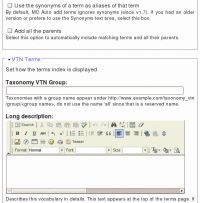
more
Creating Groups with Taxonomy VTN
Taxonomy VTN adds many fields in your taxonomy forms. When editing your taxonomy, one field is called Taxonomy VTN Group. This field is used to group different vocabularies (i.e. taxonomies) together in a group.
 The field accepts one or more group names. The names are case insensitive and are separated by commas. For instance, you could have three names such as: Kitchen, Utensils, Stainless Steel. Then another vocabulary could mention Kitchen and yet another Utensils, Wood.
The field accepts one or more group names. The names are case insensitive and are separated by commas. For instance, you could have three names such as: Kitchen, Utensils, Stainless Steel. Then another vocabulary could mention Kitchen and yet another Utensils, Wood.
The groups change the display in the Taxonomy VTN root page. A specific group can also be accessed using the URL:
Wait For Frame (dynamic)
Pop a value or a string used as the frame number or name to wait for. The frame can be specified as with the Goto Expression. If the frame was not reached yet, skip the following f_skip actions.
WARNING
Push Data
Push some immediate data on the stack. This action was introduced in V4.0. The supported data types vary depending on the version of the player you have. As many values as necessary can be pushed at once. The f_push_data structure will be repeated multiple times as required. For instance, to push two strings on the stack at once, you would use the following code:
96 0C 00 00 't' 'e' 's' 't' 00 00 'm' 'o' 'r' 'e' 00
Most of the time, it is a good idea to push more data and then use the Swap action to reorder. Extra PushData ...
Instance Of
Pop the name of a constructor (s1 - ie. "Color") then an object (o2). Checks whether the object is part of the class defined by the named constructor. If so, then true is push on the stack, otherwise false.
Since SWF version 7, it is possible to cast an object to another using the Cast Object action. This action returns a copy of the object or Null, which in many cases can be much more practical.
Implements
This action declares an object as a sub-class of one or more interfaces. The syntax here is simple, the real implementation is quite unbelievably difficult to fathom.
The following shows you how you can add an implements of interfaces "A" and "B" to the class "C". Notice that class "C" needs to already exist. Here we assume that all classes are defined in the global scope.
push data "_global" get variable push data "A" get member push data "_global" get variable push data "B" get ...
Get URL2
Pop two strings, the URL (s2) and the target name (s1).
All the usual HTML target names seem to be supported (_top, _blank, <frame name>, etc.) You can also use the special internal names _level0 to _level10. _level0 is the current movie. Other levels, I'm still not too sure how these can be used.
Sprite Properties
The following is the list of currently accepted properties or fields for the Get Property and the Set Property actions. Note that the properties can be specified with either an integer (type 7, requires V5.0+) or a single precision floating point (type 1, V4.0 compatible). And since strings are automatically transformed in a value when required, one can use a string to represent the property number (type 0).
Duplicate Sprite
Chr (multi-byte)
Pop one integer, use it as a multi-byte string character code and push the newly created string on the stack.
The integer can be any number from 0 to 65535, although many codes are not valid characters.
For more information about valid characters, please, check out the Unicode Consortium.
DefineScalingGrid
This definition is used so the scaling factors applied on an object affects only the center of the object fully. The borders are only affected in one direction and the corners are not scaled (note, restrictions apply, see below.) This is quite useful to draw a scalable button or window.
Fig 1 — Sample button being scaled with a scaling grid
